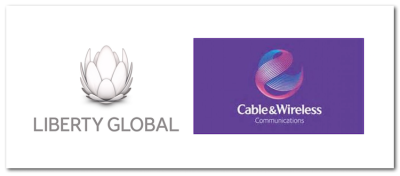 In early November 2015 the Caribbean telecom landscape changed dramatically never to return to any seemingly humdrum flow of bits across undersea fiber like soft shallow waves lapping on the sandy shores. One simple announcement flittered across the news channels with little regional fanfare: “Liberty Global buys CWC“.
In early November 2015 the Caribbean telecom landscape changed dramatically never to return to any seemingly humdrum flow of bits across undersea fiber like soft shallow waves lapping on the sandy shores. One simple announcement flittered across the news channels with little regional fanfare: “Liberty Global buys CWC“.
At a glance this non-descript headline seems innocent. You would not be faulted for skipping over it and turning to the funny pages. However, if you dove into the first couple paragraphs it would begin to dawn on you that an era of the UK-dominated Caribbean communications infrastructure had come to a swift end and that we are now entering fresh territory with a US global conglomerate taking firm control of the majority of the region’s communications infrastructure.
It isn’t the first time that the relatively calm telecoms Caribbean waters witnessed a big splash. Just one year before, almost to the date, the very CWC had acquired Columbus International, commonly known in the region as Flow to all its cable and retail Internet access customers.
At the time of that announcement Digicel had cried foul, but would have been better served to cry fowl and arrange some accompanying seasoning and sauce, for all the attention paid to their protests by regulators and consumers. I personally haven’t heard a great deal from them after this current deal.
This is possibly because they are deep in a significant fiber roll out and/or on a feverish hunt for relevant content to grab the interests of consumers for example their recent purchase of Jamaica’s Paymaster.
Or maybe they are examining the behemoth that is now their regional neighbour and competitor and thinking that the proverbial writing may well be on the wall. Time alone will tell. However we can look back through time to gather some insights into the present mix of cables before us.
In this article, I’ll take a quick look at the C&W Flow merger that led to the birthing of a new entity and laid the groundwork for this present deal. In a second piece, we’ll examine what these developments could mean for the region.
Back in 2014, eons ago, the then CWC CEO Phil Bentley announced that CWC was buying Columbus Int’l for approximately US$3 billion.
The Jamaica Gleaner on Nov 7th 2014 in capturing Digicel’s opposition to the deal reported,
“The parties have a conditional agreement on the cash and shares transaction for 100 per cent of Columbus’ equity, but Digicel is already signalling that it will be seeking the intervention of regulators, saying the deal raises issues about competition.
Under the agreement between the parties, CWC will pay cash of US$707.5 million and issue 1,557,529,605 new ordinary shares in CWC to three Columbus shareholders, giving them 36 per cent ownership in Cable & Wireless. The cash and share issue are valued at US$1.85 billion. Columbus’ debt of about US$1.2 billion will also be assumed by CWC.”
That to me seemed like a sweet deal with the resulting percentage ownership of CWC not being a bad thing at all. And if you were wondering who the three shareholders of Columbus were, the Gleaner went onto say,
“The new CWC shares – totalling 9.99 per cent of the British telecoms’ outstanding share capital – will be issued to investment vehicles controlled by director and co-founder of Columbus, John Risley, shareholder John Malone, and president, chief executive officer and co-founder of Columbus, Brendan Paddick.”
It was so innocently stated, investment vehicles controlled by the three men named, that one could miss the second name who is no stranger to big deals and whose company is a giant in the cable industry. It struck me at the time as curious that the deal focused more on shares than on cash, for one very significant reason.
As the Gleaner reported a week later on Nov 14th 2014,
“Jamaican-Canadian investor Michael Lee-Chin, whose firm Portland Private Equity (PPE) co-founded Columbus International Inc with the Risley group around 2005… PPE is now a minority shareholder in Columbus with a reduced 13 per cent stake. It started with almost 50 per cent shareholding and, over time, has invested US$65 million of its own funds in the telecoms. Its 13 per cent share of the US$1.85 billion offer would, by Financial Gleaner estimates, work out to US$240 million.
Three shareholders, Brandon Paddick, John Risley and John Malone, will take a 36 per cent stake in CWC under the deal, but Lee-Chin’s payout is expected to be in cash only. Lee-Chin said he would completely exit his investment in Columbus when the transaction closes.”
At the time of these developments, I was not yet writing this blog post and you weren’t involved in the conversations with my friends. So I won’t try to convince you that we believed that there was a bigger play at hand but needless to say the divergence in agreed compensation, cash vs shares in the resulting entity at that critical juncture was an indication that the game was about to change. The stage was clearly set for a lot of developments.
Is any of this bad? Not as far as I’m concerned!
We need to have as much development and growth in our region in the delivery of all services. But your perspective is of course shaped by which side of the fence you’re viewing the grass from. So let’s consider the matter from a Digicel point of view.
Around the time of this announcement, Digicel had been rolling out undersea fiber and feverishly working on their Fiber-to-the-Home product. Digicel had also been digesting Claro for about 2 years after a bumpy entrance into Central America, home of America Movil.
This somewhat shaky expedition appears to have irked the telecoms jefe Carlos Slim, who responded by storming the Jamaican market under the brand Claro. After a 2011 “gentleman’s agreement”, Claro then exited Jamaican operations.
Over the next few months following the CWC Flow merger announcement, Digicel also began preparing for a listing on the exchange in New York in early October 2015. According to the Irish Times the principal at Digicel Mr O’Brien and Digicel itself were in a tenuous financial situation.
“Nobody can afford to lose more than €500 million on an investment, as happened to O’Brien with INM, it is argued, while he has also had to refinance his substantial IBRC borrowings.
Yet the structure of Digicel’s proposed IPO would appear to contradict this theory. While O’Brien was surrendering 40 per cent of the equity in Digicel, he was not taking any money off the table directly.
His investment vehicle Island Capital stood to earn up to $10 million as an advisory fee from a successful IPO that would have been small compared with the hundreds of millions O’Brien could conceivably have earned from a share sale.
Instead, the proceeds were earmarked to repay some of Digicel’s $6.5 billion debts and to fund about $400 million of new media acquisitions.
He has also earned a hefty $1.1 billion from Digicel in dividend payments over the past three years and currently receives $10 million per quarter from the company. “
Things did not improve for Digicel when, according to O’Brien, market conditions were not suitable for the IPO and 72 hours before opening for trading the IPO was cancelled.
From that side of the fence, it was probably not a welcome development when the Liberty-CWC merger was announced. Digicel whilst large is still carrying a lot of debt and now must face off against a competitor who is leaps and bounds ahead in the fiber game with all of the acquired Columbus and CW infrastructure.
So where are we at right now? We have a verifiable telecoms behemoth called Liberty Global that has been assembled from some European acquisitions who, having consumed CWC and folded it under the LiLAC listing, seem intent on invading the Latin American Market. We also know that America Movil won’t take the market entrance lying down.
So the conditions are ripe for a very exciting next few years. Will former enemies, Claro and Digicel put aside any differences and join forces to battle LiLAC? Is there much motivation for Claro to be join forces with Digicel?
Based on declines in wealth last year for Carlos Slim who according to Bloomberg was the year’s biggest loser suffering a loss of approximately $20 billion, it’s very possible.
“Since the start of 2015, the Mexican executive’s fortune has declined almost $20 billion, or about the size of Honduras’s economy, to $52.8 billion, according to the Bloomberg Billionaires Index. The shares of his America Movil SAB telecommunications giant are heading for their biggest decline since 2008. The company has suffered under regulatory pressures in Mexico, where it’s now forced to share the infrastructure that allowed it to dominate the mobile and fixed-line market for more than a decade.
Among conditions working against Mexico City-based America Movil are: a dismal outlook for Brazil’s economy, its second-biggest market; stronger competitors at home; and limited opportunities to expand in Europe. Slim, now the fifth-richest person in the world — down from third earlier this year — owns 57 percent of the company. The stock, down 18 percent this year, lost its long-held position as the most-weighted stock on Mexico’s benchmark index, making Slim the biggest loser among the world’s 400 wealthiest individuals.
The telecommunications company has relied on Brazil, Austria and the U.S. to expand, as regulation weakens the competitive advantage America Movil has enjoyed in Mexico, where it controls about 70 percent of all mobile phones and 62 percent of fixed lines. On top of that, AT&T Inc. bought two rival businesses in Mexico — NII Holdings Inc.’s Nextel Mexico business and Grupo Iusacell SA — pressuring prices and increasing the battle for users in its home market.”
Will Claro duke it out with Liberty on its own and Digicel keep low out of the Liberty’s gunsight? Based on these significant losses with a need to grow in a soon to be more fierce competitive environment, my money is on the “frenemy” model, with the establishment of what can be termed an alliance of common interests.
Either way, the expectation of increased competition is that consumers will be reaping the fruit of the battle for eyeballs. The content wars are what naturally follow the mad rush for infrastructure consolidation. So lower prices hopefully and more content available for consumption are among the benefits that consumers can expect.
However, the region should not stop there but seek out what are the new opportunities for innovative activity presented by this new communications context. We must harness our creativity and seek to quantum leap into a new era of producing relevant information-based products and services.
 Andre has over 15 years of experience in the Caribbean technology industry, contributing to a mix of private sector and non-profit projects deploying ICT solutions leveraging networking and hosted infrastructure management. He is the Business Development Manager for Mobile Products at Teleios Systems and a member of the coordinating team for the Caribbean Network Operators Group. Follow on Twitter: @AndreMEdwards.
Andre has over 15 years of experience in the Caribbean technology industry, contributing to a mix of private sector and non-profit projects deploying ICT solutions leveraging networking and hosted infrastructure management. He is the Business Development Manager for Mobile Products at Teleios Systems and a member of the coordinating team for the Caribbean Network Operators Group. Follow on Twitter: @AndreMEdwards.

 eCommerce3 months ago
eCommerce3 months ago